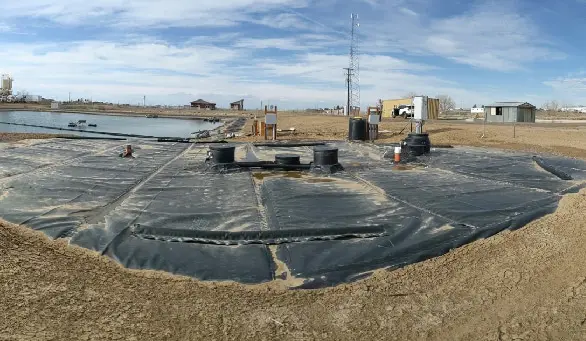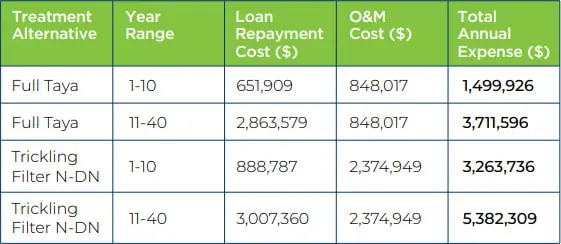A NOVEL APPROACH TO BIOLOGICAL WWT,
SAVING MILLIONS OF DOLLARS IN CAPEX & OPEX
A COMPETITIVE FEASIBILITY STUDY OF TAYA TECHNOLOGY
This article is an overview of a feasibility study carried out by Dr. Menahem Libhaber for a treatment plant in a city in Latin America. Dr. Libhaber conducted an economic and financial comparison of a TAYA treatment plant and a Trickling Filters plant with nitrification – denitrification (Trickling Filters N-DN).
Both studies took place under the conditions of a greenfield in a Latin American city. Each plant has the capacity to treat 54,000 m³/d of raw municipal wastewater with a BOD concentration of 290 mg/l and a total nitrogen concentration of 67 mg/l. Each plant will serve a population of approximately 400,000 and will also treat commercial wastewater.
The TAYA ECO wastewater plant consists of a preliminary treatment unit, three parallel covered anaerobic lagoons and 18 pairs of TAYA reactors. Sludge drying beds are also a part of the plant’s treatment system. The trickling filter wastewater treatment plant removes BOD as well as nitrogen.
The cost of the trickling filters plant was estimated by the consulting firm that designed the plant (a feasibility design level). The estimated cost for the TAYA components was made by TRIPLE-T and was regarded as accurate. To derive the cost of the other plant’s components (preliminary treatment, anaerobic lagoons and drying beds), the team used reliable data from another plant in the area.
ECONOMIC ANALYSIS
Table 1: Results of the economic comparison of TAYA & Trickling Filters N-DN treatment plants each treating 54,000 m4/d of municipal wastewater in Latin America
The investment in the trickling filter plant is a bit higher than the investment in the TAYA plant. The economic analysis shows that in economic terms (considering the present value of total investments plus annual expenses), the TAYA alternative is a preferred alternative because its O&M costs are much lower.

FINANCIAL ANALYSIS

The financial analysis refers to the comparison of the annual cost that the regional water and sanitation company will have to pay for each of the two alternatives. The analysis assumes that the company obtains a concessional loan from one of the international financing agencies (i.e. the World Bank, IDB, CAF, KfW or JICA) but has to pay the O&M costs from its internal budget / cash generation since the international financing agencies do not finance O&M costs. Hence the annual cost of each alternative will be the Annual Loan Repayment amount plus the Annual O&M cost. In this arrangement, OPEX savings are crucial.
Assuming all the mentioned international financing agencies provide loans at similar lending terms, the team used World Bank’s current lending terms for a loan in US$ to the country in which the treatment plant is located, as specified:
Interest rate: 1.3%
Grace period: 10 years
Maturity: 40 years
The significance:
Year 1 to 10: repayment of interest only
Year 11 to 40: repayment of the loan and the interest
Table 2: Results of the financial analysis – comparison of annual costs of the full TAYA alternative and the Trickling Filters N DN alternative

* All costs are per year and pertain to the treatment plant in the Latin American country
The financial analysis shows that the TAYA outshines the Trickling Filter alternative since its total annual cost for the water and sanitation company is significantly lower.
.tb_button {padding:1px;cursor:pointer;border-right: 1px solid #8b8b8b;border-left: 1px solid #FFF;border-bottom: 1px solid #fff;}.tb_button.hover {borer:2px outset #def; background-color: #f8f8f8 !important;}.ws_toolbar {z-index:100000} .ws_toolbar .ws_tb_btn {cursor:pointer;border:1px solid #555;padding:3px} .tb_highlight{background-color:yellow} .tb_hide {visibility:hidden} .ws_toolbar img {padding:2px;margin:0px}
TAYA ECO PLANT SAVES MILLIONS OF DOLLARS
IN CAPEX & OPEX
Overall, the TAYA ECO plant demonstrated a clear economic value, saving $2.5M in CAPEX and $1.5M in OPEX per year. Coupled with the simplified, easy operation, a TAYA plant is a preferred choice.
TAYA plants are also superior from the environmental footprint aspect since they generate minimal excess sludge.
Traditionally, wastewater treatment faces significant regulatory and cost challenges. The TAYA technology presents a novel approach to biological wastewater treatment. TAYA relieves the burden by dramatically reducing operational cost, labor and eco-footprint, while providing extraordinary ease of use and peace of mind.
ABOUT MENAHEM LIBHABER
Dr. Menahem Libhaber holds a D.Sc. degree from the Water Resources and Environmental Engineering Department of the Technion, Israel Institute of Technology in Haifa, Israel. He has about 40 years of global experience in the field of wastewater treatment. For 18 years he worked for Tahal, an engineer consulting firm, as a Water and Sanitation Engineer in Israel and abroad. He continued his career with 20 years as a Lead Water and Sanitation Specialist in the Sustainable Development Department of Latin America and the Caribbean Region in the World Bank. Menahem retired from the World Bank in 2010 and presently works as an individual consultant to the World Bank and other entities (private companies and governments). He wrote numerous technical articles and co-authored two books published by the International Water Association (IWA).



